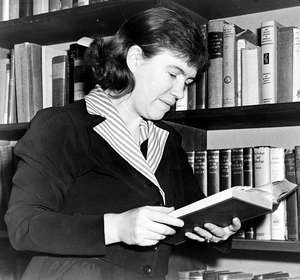
Margaret Mead
[pdf] Draft Kinseyan Anthropology by Judith Reisman
Books
[1999] The Fateful Hoaxing of
Margaret Mead by Derek Freeman
[1983] Margaret Mead and Samoa: The Making and
Unmaking of an Anthropological Myth by Derek Freeman
Quotes
Freeman retraced Mead's skimpy time in the out-of-the-way
islands of Manu'a in the mid-1920s and documented her
ďanthropological fieldwork" as an
Margaret Mead's 1928 Coming of Age in Samoa, a report of her
anthropological study of adolescent girls and a triumph of cultural relativism,
firmly established her as a guiding voice of anthropology. Her work was mostly
unquestioned during her lifetime, but in 1983 anthropologist Derek Freeman
released a critical review of her work, showing that her assertion that
adolescence in Samoa is easier because of free sexuality (upon which she based
her nurture-over-nature theories) is in conflict with the facts of Samoan life
and even with her own field notes. He suffered insult and approbation from
nearly every member of the scientific establishment, to whom Mead was a hero and
a saint, but he has rejoined the fray, perhaps to finish it, with The Fateful
Hoaxing of Margaret Mead.
This scholarly review examines all of the primary sources related to Mead's
fieldwork and the important 1987 recanting of one of her informers. Forcefully
written and carefully constructed, Freeman's book shows that Mead's stay in
Samoa was too brief and too consumed with a much larger ethnographic project to
have accumulated much data on adolescent sexuality. Her need to finish the
project and her fervent belief in culturalism then led her to accept the joking
references of her two closest informers about free sex as truth. Careful to make
it clear that his focus is on Mead's science, Freeman shows that it is extremely
unlikely that Mead deliberately falsified her report, simply that her
preconceptions blinded her to inconvenient facts. Given the impressive evidence
arrayed here, it's hard to see how Mead's work in Samoa can be now viewed as
anything but a pretty fable. --Rob Lightner --This text refers to an out of
print or unavailable edition of this title. [1999]REVIEW: The Fateful Hoaxing
of Margaret Mead: An Historical Analysis of Her Samoan Researches by Derek
Freeman
In my early work I had, in my unquestioning acceptance of Mead's writings, tended to dismiss all evidence that ran counter to her findings. By the end of 1942, however, it had become apparent to me that much of what she had written about the inhabitants of Manu'a in eastern Samoa did not apply to the people of western Samoa...Many educated Samoans, especially those who had attended college in New Zealand, had become familiar with Mead's writings about their culture...[and] entreated me, as an anthropologist, to correct her mistaken depiction of the Samoan ethos. ----Derek Freeman